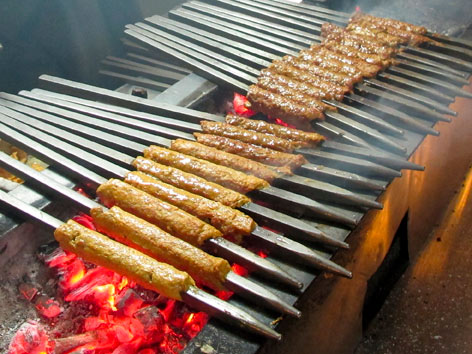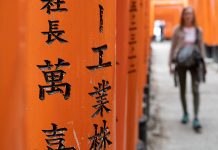Lahore, the capital city of Pakistan, is known as the heart of the country. But it’s just as famous for its delicious, spicy Lahori foods as for its history and culture. The city’s cuisine is a perfect blend of Mughlai, Persian, Kashmiri, and Punjabi flavors, giving it a unique taste and identity.
The food of Lahore is known for its bold flavors, tandoori specialties, and traditional breakfasts. Famous Pakistani dishes like nihari, paaye, seekh kebab, halwa puri, BBQ, and chargha can be found on almost every street corner. You’ll find luxury restaurants in Lahore, but also countless small dhabas and street food stalls offering mouthwatering snacks like tawa chicken, gol gappay, and pathoray.
Key ingredients in Lahori cuisine include meat (beef, mutton, chicken), yogurt, spices (cumin, coriander, garam masala), desi ghee, and tandoori naan. Side servings like mint-coriander chutney, pickles, and raita are common, enhancing the overall taste of the dishes. The iconic Lahori breakfasts of halwa puri, channay, and nihari are must-tries, and available in nearly every corner of the city.
For food lovers, Lahore is nothing short of heaven. As the saying goes: If you haven’t tasted Lahore’s food, you haven’t tasted the real flavor of Pakistan.
If you find yourself heading to Lahore, here are eight traditional Pakistani dishes you must try.
Pakistani nihari. Photo courtesy of noongraphy/Freepik.
Nihari
Let’s start with one of Lahore’s most beloved foods, nihari–the national dish of Pakistan. Although it’s enjoyed across the country, when it comes to taste and tradition, it wouldn’t be wrong to say that Lahore serves the best nihari.
Nihari is a slow-cooked meat stew thickened with flour, fragrant with spices, and served with naan bread. In Pakistan, nihari is commonly made with beef or mutton, but lamb, goat, or chicken are also used. Many people prefer its savory broth to the meat itself, as it provides essential warmth and comfort on cold winter days.
Nihari was first prepared in Old Delhi, India, during the 18th century in the Mughal era. At that time, Muslim nawabs ate it for their morning breakfast. After the subcontinent’s Partition in 1947, nihari became Pakistan’s national dish. It’s still loved in both Pakistan and India.
Where to find it: Nihari is easily found across Pakistan and in Lahore at various restaurants. For the best atmosphere and taste, head to Waris Nihari (map) or Muhammadi Nihari (map), which is known across Lahore for its nihari (and even has camel nihari).

Pakistani seekh kebab. Photo courtesy of EyeEm/Freepik.
Seekh Kabab
Seekh kabab is one of Pakistan’s most famous BBQ dishes, and the smoky, perfectly spiced, and juicy seekh kabab of Lahore particularly stands out. These kababs are commonly found on the capital’s local streets.
Seekh kababs are made from minced lamb or beef mixed with fresh coriander, green chilies, garlic, ginger, and a blend of aromatic spices. Chicken seekh kababs are also quite popular. These are typically enjoyed at dinner, served with naan or roti, and paired with spicy mint-coriander chutney.
The name comes from the traditional skewers (seekh) used to cook them over an open flame, giving them a slight char and smoky flavor. Its origins likewise date back to the Mughal era, as seekh kebabs were part of the royal feast. Today, you can find this in both small eateries and high-end restaurants.
Where to find it: If you’re in Lahore and want delicious seekh kababs in a great atmosphere, check out Bhayya Kabab Shop (map) or Baba Jamal Tikka Shop (map).

Pakistani chicken karahi. Photo courtesy of Freepik.
Chicken Karahi
Chicken karahi is one of the most popular dishes in Pakistan and a signature meal in nearly every household. Although the exact origins of the dish remain unclear, chicken karahi is renowned worldwide and is extensively mentioned in many cookbooks.
It is a flavorful, spicy dish made with chicken, tomatoes, green chilies, and aromatics like ginger, garlic, and coriander. Chicken karahi is typically served with naan or roti, and a squeeze of lemon to enhance its taste. It is often enjoyed during lunch or as a late-night meal in both Pakistan and India, where it is equally loved.
The dish is said to hail from the Khyber Pakhtunkhwa province of Pakistan. The name “karahi” comes from the deep, round-bottomed cooking pot in which the dish is traditionally prepared.
Where to find it: For a terrific Lahori karahi experience, check out Butt Karahi (map) or Khan Baba Restaurant (map); both are famous for it.
Paaye
Paaye is a beloved dish in Lahore that’s often enjoyed for breakfast or lunch at local eateries. Rich and spicy, it is made by slow-cooking mutton trotters until they release their flavors into a hearty broth. Desi ghee, yogurt, and spices are used too. The creamy bone marrow and deep, aromatic flavors make paaye a standout Pakistani dish.
Paaye is famous for its sticky, gelatinous texture. Some consider it an acquired taste; others savor its distinct flavor. Beef paaye is richer and often served alongside nihari, while goat paaye is lighter and best suited for breakfast.
This dish is rooted in both South Asian and Central Asian cuisines. But paaye was perfected by chefs from Lahore, Hyderabad, and Lucknow, making it popular in Pakistan and India alike.
Where to find it: Lahore is home to many markets where traditional dishes like paaye are served at affordable prices in vibrant settings. For a great experience, visit Fazal Din Phajja Siri Paaye (map) or Haneef Siri Paaye (map), pictured above, both renowned for their exceptional paaye.

Halwa puri. Photo courtesy of @thefoodsgazette/Instagram.
Halwa Puri
Halwa puri is considered Pakistan’s traditional breakfast, but in Lahore, it is the most famous and favorite breakfast, enjoyed by many.
This is a meal composed of three parts: a subtly spicy and tangy chickpea and potato curry, sweet semolina pudding (halwa), and deep-fried puffy puris. It’s typically prepared in desi ghee or oil, and served hot. The combination of sweet-and-savory flavors makes a morning special, so Lahoris thoroughly enjoy halwa puri for breakfast. (You’ll find similar sweet-spicy breakfasts in Delhi too.)
The roots of halwa puri trace back to the Mughal era, known for its grand feasts and innovative culinary traditions. Nowadays, the famous halwa puri shops of Lahore are packed with people every weekend.
Where to find it: Some of the best halwa puri in Lahore can be found at Taj Mahal Sweets (map), established in 1967, and at Sadiq Halwa Puri (map), which dates back to 1880 and claims to have invented the dish. Capri Restaurant (map) is also very popular (pictured above).

Chicken biryani. Photo courtesy of Freepik.
Lahori Biryani
Calling biryani, one of Pakistan’s most famous and beloved foods, just a dish would be an understatement—it’s an emotion! And Lahori biryani stands above the many iterations of this dish with its aromatic spices and delicious flavor.
Lahori biryani pairs tender meat (most commonly chicken) and fragrant basmati rice with a mix of whole and ground spices, including cloves, cinnamon, cardamom, and cumin. Ginger, garlic, onions, chilies and ghee are also added, creating a luxurious dish with deep, aromatic flavor when cooked correctly.
Like many of Pakistan’s best traditional dishes, biryani’s origins trace back to the opulent Mughal era, where it was influenced by Persian and Central Asian cuisine. Legend has it that Mumtaz Mahal, the wife of Emperor Shah Jahan, had it specially prepared for soldiers. Over time, biryani evolved to become a culinary treasure across South Asia, and in Pakistan, it’s one of the most loved dishes.
Where to find it: For great biryani in Lahore, we like Waqas Biryani House (map) or Biryani King Shadman Main Branch (map).

Rabri falooda. Photo courtesy of Ali Rehman/Facebook.
Falooda
Falooda is a popular sweet delicacy in Lahore, and across Pakistan. Made with rabri–a traditional sweet of boiled milk, cream, sugar, nuts, and cardamom–along with milk, vermicelli noodles, basil seeds, and ice cream, it is typically served in a bowl and topped with rose syrup, giving it a rich, floral taste. Falooda’s creamy texture and distinct flavor instantly wins hearts.
Even in wintertime, Lahori falooda is a perfect treat. The rose syrup and crushed ice makes it refreshing despite its richness. Falooda is another Mughal-derived dish, inspired by Persian and Central Asian desserts before it took its place as a staple sweet dish in South Asia. Today, it is one of Pakistan’s best street desserts (rabri falooda is a popular street food in Delhi too, where it’s often served in a drinking glass).
Where to find it: For falooda in Lahore, visit Mashallah Nafees Kasuri Falooda (map) or Yousaf Falooda (map). Both have been renowned for this dish for decades.
Lassi
Lassi is an essential and traditional part of breakfast in Lahore. This thick, creamy, and chilled yogurt-based beverage comes two ways: sweet or salty. Both are famous and equally loved for their delicious, refreshing taste. Lassi is also the perfect way to beat the summer heat (and combat the heat of chiles, if needed!).
Lahori lassi is made with yogurt, milk, and crushed ice. Sweet lassi is flavored with sugar, while salty lassi gets a pinch of salt. The combination of creamy yogurt, rich milk, and cold ice makes every sip cooling and satisfying.
The history of lassi stretches back thousands of years to the Punjab region. The drink became popular across Northern India and Pakistan for its nourishing, refreshing qualities. During the Mughal era, lassi was a favorite in Lahore, especially on hot days. In Lahore’s old markets, lassi isn’t just a drink—it’s a symbol of hospitality and Punjabi culture.
Where to find it: For the best lassi in Lahore, go to Jeda Lassi Butter Milk (map) or Chacha Feeka-Peray Wali Lassi Wala (map), where you can get your lassi topped with khoya and/or pera, a sugary sweet (pictured). These legendary spots have been serving creamy, delicious lassi for decades, attracting long lines of customers every day.
About the author: Malik Bilal is a professional content writer and SEO expert based in Sargodha, Pakistan. You can connect with him on Facebook.
There has never been a better time to plan your next trip and make your Dream vacation a reality . Whether you've been dreaming of relaxing on a sun-kissed beach, exploring ancient cities, or embarking on an epic adventure, now is the perfect moment to make it happen.













